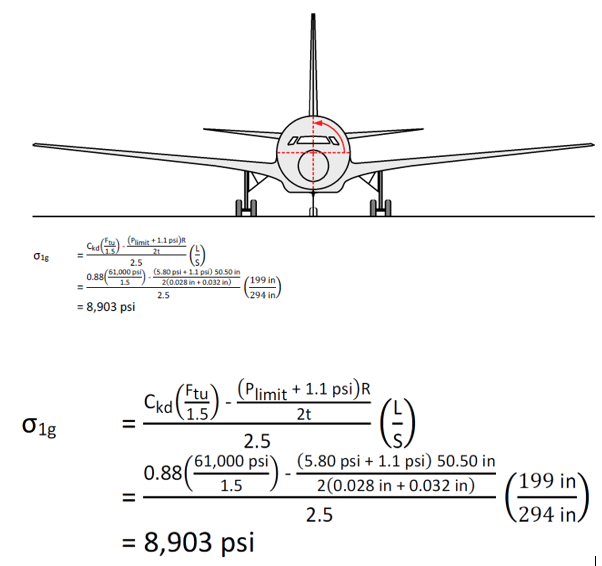IBD,
As for Item 1, that is not a formula for stress intensity, those Kt values are stress concentration - there is a difference. I'm not sure where the exact numbers 61.23 and 386.09 come from because there is no analytical context. I'm guessing you're following an example and those are what someone else had.
To me those should be bearing and bypass stresses. The value "gamma" is the ratio of bearing to bypass stress even though they are presented as loads there. Basically, they are saying the peak stress arises from three sources... bypass stress, bearing stress, and secondary bending. You only want to apply each Kt to the matching portion of stress.
As for Item 2... kind of a misnomer in your title. This is NOT calculating an equivalent stress. A single-cycle equivalent stress is an equivalent GAG cycle stress which causes the same fatigue damage as the actual applied fatigue spectrum. You would need a spectrum factor as appropriate. There are simplified methods for calculating an equivalent stress, this is not one of them.
The formula you have there is a stress due to
fuselage inertial bending. It assumes a linear reduction in stress from the wing box to the extreme points of the fuselage. Hence, you L/S is the portion of the distance to the end of the fuselage. "L" would be at the location of interest, "S" would be total length from wing box to the end.
HOWEVER, a word of caution:
Please read these threads:thread2-405011 , thread2-445681
What you are looking at here is the
UDRI Method. I will briefly summarize what I stated in the second thread referenced above (relevant parts):
LiftDivergence said:
RE: your question about the Safarian approach to bending - in his course he presents the UDRI method which can be used to find an additional longitudinal tensile stress in the crown due to body bending. I think this is much better than the often referenced "Broek method", since UDRI essentially reverse engineers a 1g stress from material ultimate conditions, whereas Broek assumes a distribution based on a balanced aircraft with essentially zero tail input required for balancing.
If you want more of a discussion on this, see this thread:
thread2-405011: Fuselage Bending
Very good discussion in there between rb1957 and crackman
So, that is only one part of your total stress, and it does not account for fatigue spectra.
Also note: UDRI Method is presented in Section 4.4.2 of AC TC12-17. You need to be careful about what you use for Ckd and you internal pressure differential.
You can also see this method presented in Appendix C6.1 - 6.2 of RAPID, but actually in more detail. You are missing a couple things like (Z/r) and an additional payload factor depending on which "zone" you are in.
You can also read Safarian's advanced DT course notes where he covers (simply) a stress reduction due to substructure and Poisson effects.
Keep em' Flying
//Fight Corrosion!




